Montana is called Big Sky Country, and it’s easy to see why. The state’s landscape is characterized by sweeping arid grasslands, rolling prairies, and towering mountains.
Two of the most iconic rivers in the United States flow through Montana — the Yellowstone River and the Missouri River. These rivers provide essential habitats and food sources for many species of waterfowl, including ducks.
In addition, Montana has 19 National Wildlife Refuges, 8 National Parks and over 10 million acreages of important bird areas.
As a result, it’s no surprise that Montana is one of the most popular destinations for duck hunters and birders from all over the country.
What Ducks Are in Montana?
These are all the species of ducks that live in Montana.
Barrow’s Goldeneye
Bufflehead
Canvasback
Cinnamon Teal
Common Goldeneye
Gadwall
Garganey
Mallard
Northern Shoveler
Redhead
Ring-necked Duck
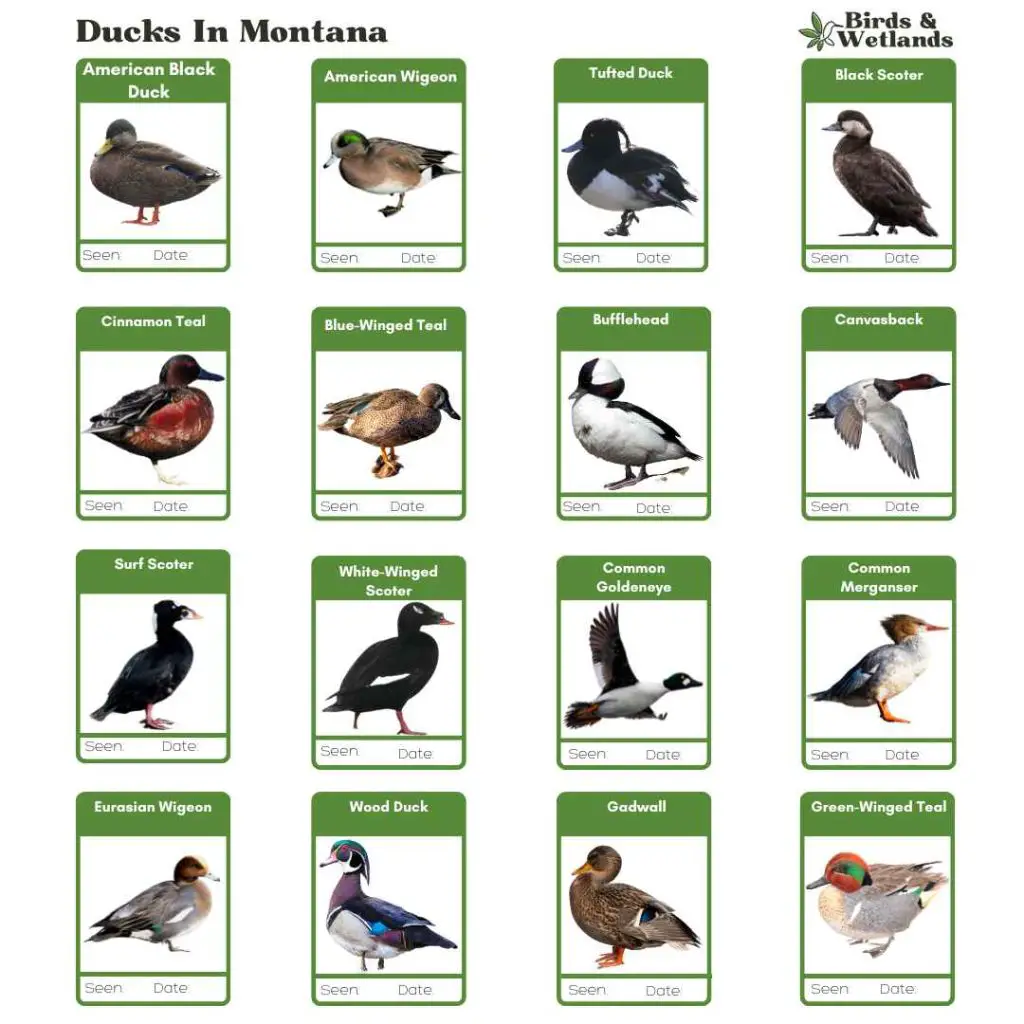


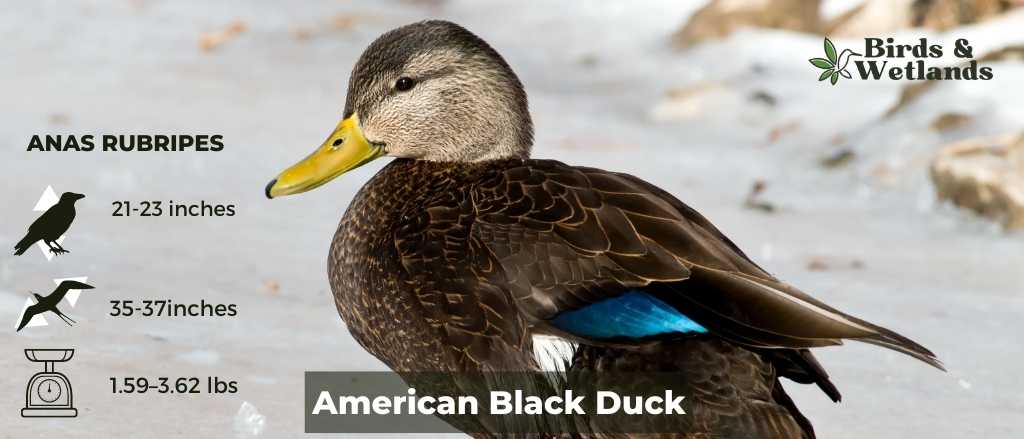
American Black Duck
Listen to American Black Duck
The American black duck belongs to the Anatidae family of big dabbling ducks. American Black Ducks are easily identified by their black plumage and white markings on the face and wingtips.
The males also have an orange bill with a dark tip while females have dark gray bills with white spots on top. Both sexes have dark gray legs and feet which help them blend in with their surroundings.
They are omnivores, but mainly eat aquatic plants such as algae and duckweed. They also eat insects, small fish, snails, and seeds from land plants like clover or grasses which grow near bodies of water where they live.
The habitat for the American Black Duck is ponds and lakes in North America, Europe, Asia, and Australia. They are migratory birds and breed in northern regions like Alaska, Canada, and the northern United States. They have been known to nest on islands when they cannot find a suitable wetland habitat.
The current population of the American Black Duck is estimated to be around 1 million birds.
Scientific Name: Anas rubripes
Height: 54–59 cm (21–23 in)
Wingspan: 88–95 cm (35–37 in)
Weight: 720–1,640 g (1.59–3.62 lb)
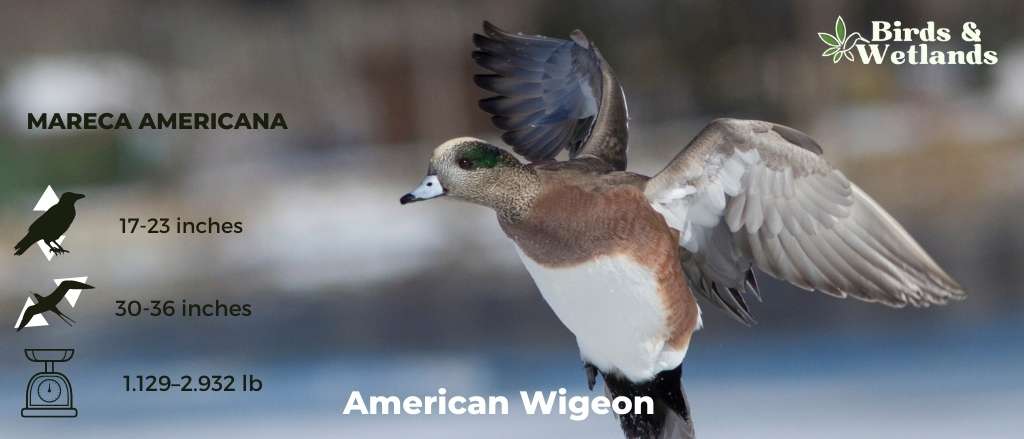
American Wigeon
Listen to American Wigeon
The American Wigeon, also known as the baldpate, is a medium-sized duck that is native to North America, Europe, Asia, and northern Africa.
American Wigeon is known for its bright plumage: males have a blue head and neck with a white breast and belly; females have a brown head with a white eye stripe and yellowish markings on the breast and belly. They also have short legs with two toes on each foot which enable them to walk easily on land or water.
Their diet consists of aquatic vegetation and seeds. They mainly eat aquatic plants, but also take some small invertebrates such as insects or snails from the water’s edge.
This species prefers areas with dense vegetation because they provide an excellent source of food for these birds during the breeding season (i.e., they can feed on aquatic plants). They are usually found in freshwater marshes, ponds, lakes, and river deltas.
They are not migratory and typically remain at the same location year-round. The current population of this bird is estimated at around 2 million individuals worldwide.
Scientific Name: Mareca americana
Height: 42–59 cm (17–23 in)
Wingspan: 76–91 cm (30–36 in)
Weight: 512–1,330 g (1.129–2.932 lb)
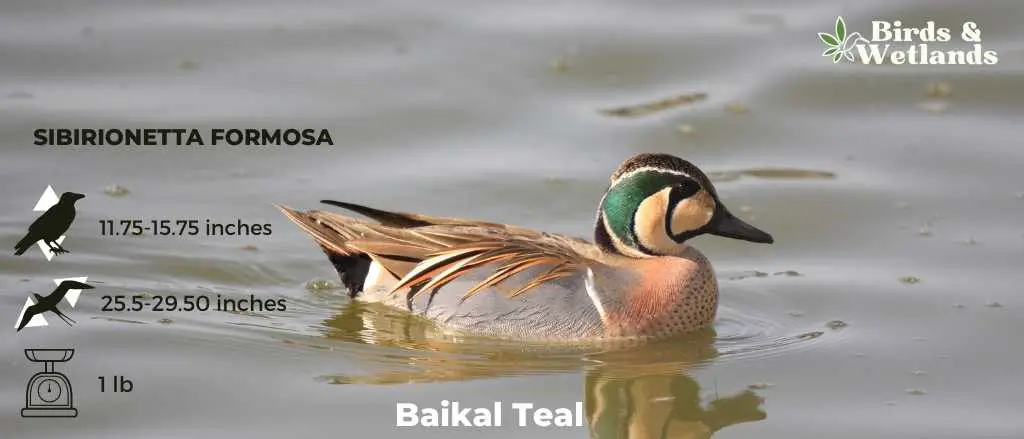
Baikal Teal
Listen to Baikal Teal
The Baikal Teal is a small duck that has a long, slender bill, and its tail is short and slightly rounded. The male’s head and neck are blue-gray, and the rest of the body is an olive color with darker brown stripes. The female’s head is brownish gray, and its body is grayish-green with light brown markings.
Baikal teals are small ducks that can migrate thousands of miles each year to follow their food supply; they spend winters in coastal areas where they feed on marine life like fish eggs and crustaceans. These small birds also eat small fish when necessary to survive harsh winters when there are no other food sources available for them to eat. They eat seeds from aquatic plants and insects found in lakes or ponds during their migration periods.
Baikal Teals are migratory birds that travel between Siberia, Alaska, and Canada during their breeding season. During the winter months, they can be found in China and Japan.
It is currently listed as “Least Concern” by the IUCN Red List due to its large population size and stable population trend.
Scientific Name: Sibirionetta formosa
Height: 11.75 to 15.75 inches
Wingspan: 65–75 cm
Weight: 1 pound
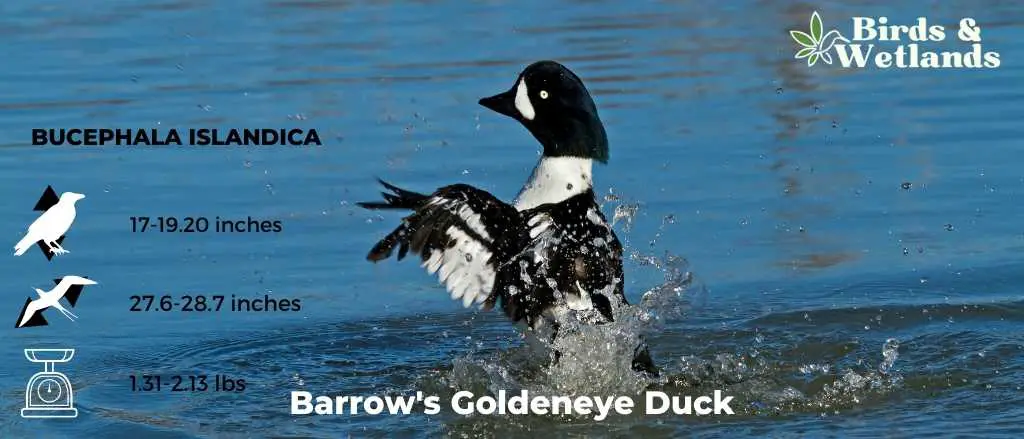
Listen to Barrow’s Goldeneye Duck
The Barrow’s Goldeneye Duck is a medium-sized diving duck with a black head and neck, a white breast, a brownish-gray back and sides, grey wings, and a white belly. It has a long, black, narrow bill that is slightly upturned at the tip.
The Barrow’s Goldeneye Duck has a diet of aquatic insects, mollusks, crustaceans such as shrimp or crayfish, and small fish.
These ducks live in both saltwater and freshwater habitats, where they breed during the springtime. They are migratory birds, traveling south during the winter months to spend time in warmer climates.
The Barrow’s Goldeneye Duck is found in the northern hemisphere from Alaska to Greenland, Europe, Asia, and northern Africa. In North America it breeds in Canada and Alaska; in winter it can be found south of California and New York.
Scientific Name: Bucephala islandica
Length:
Male: 19.2 in (49 cm)
Female: 17 in (43 cm)
Wingspan: 27.6-28.7 in (70-73 cm)
Weight:
Male: 2.13 lb (970 g)
Female: 1.31 lb (590 g)
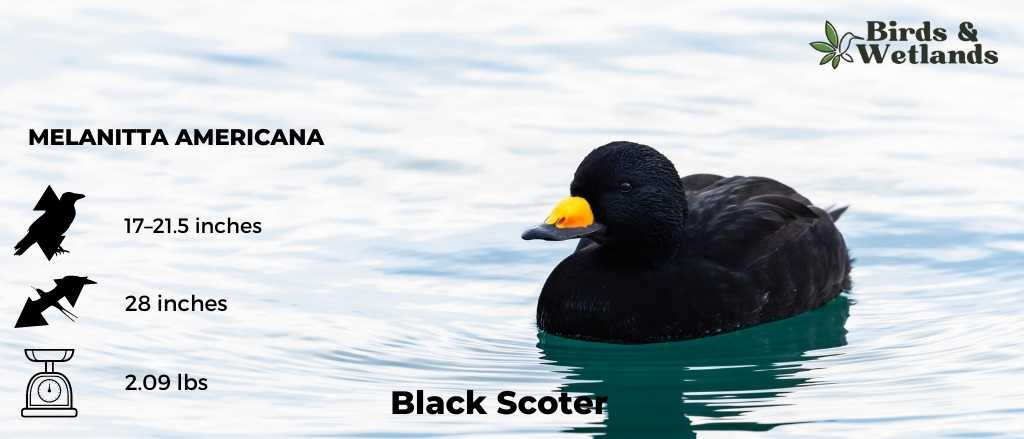
Black Scoter
Listen to Black Scoter
The black scoter, or American scoter, is a large sea duck, that breeds in the far north and winters in fresh water. These birds can be found in North America, Europe, Asia, Greenland, Iceland, and northern Russia.
It is brown with a white belly, black breast and neck, and white feathers on its flanks. The male is larger than the female, though both sexes are similar in size. The eye is yellowish-orange with a dark ring around it. The legs are yellow.
They breed in small ponds with deep water, since they prefer to nest in freshwater lakes and rivers rather than saltwater lakes. Their diet consists mainly of fish and crustaceans, aquatic plants including algae, tubers, and seeds, as well as some insects when available.
It is a migratory bird that spends most of its time at sea, but it travels to land on migration routes during spring and fall.
The current population of this species is estimated at 1 million individuals worldwide; however, there are concerns about its future because many of its populations are declining due to habitat loss caused by climate change and pollution.
Scientific Name: Melanitta americana
Length: 430–550 mm (17–21.5 in)
Wingspan: 710 mm (28 in)
Weight: 950 g (2.09 lb)
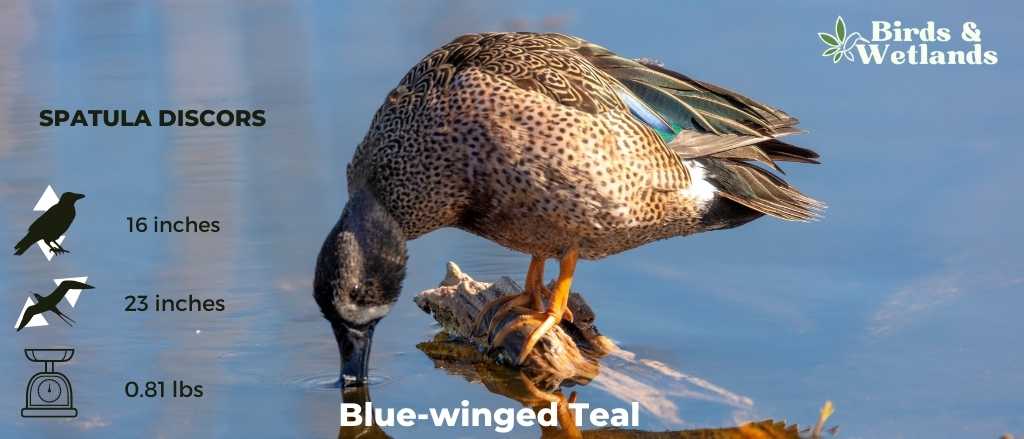
Listen to Blue-winged Teal
The Blue-winged Teal is a small duck that lives in North America. It has a glossy blue-gray head and back, with a white breast and sides. Its wings are brown with two white stripes, and its tail is also brown with white edges.
The Blue-winged Teal’s diet consists mostly of aquatic plants like pondweed, but it will also eat insects when they are available. This duck often feeds by pecking at the surface of the water rather than diving for food. It will sometimes form small groups to feed together or fly in single file formation when migrating south for winter.
Blue-winged teals are found in marshes, ponds, lakes, and rivers throughout the United States south of Canada, and north of Mexico.
They are migratory birds and fly south for the winter months to warmer climates. It winters along the Atlantic coast from southern New England to Virginia and then moves further south as far as Mexico.
Scientific Name: Spatula discors
Height: 40 cm (16 in)
Wingspan: 58 cm (23 in)
Weight: 370 g (13 oz)

Bufflehead
Listen to Bufflehead
The Bufflehead is one of the most striking birds in North America. It is a small duck with a pale head, a black breast, and a white belly. It has a black head and neck, white patches on the cheeks and throat, and a distinctive white crescent on each side of its tail.
The Bufflehead is a strong flier, but rarely flies more than several hundred yards at a time. It lives on the coast of North America, spending most of its time in salt water.
Buffleheads can eat many different types of foods including clams, crayfish (also known as crawfish), insects such as beetles and flies as well as other small animals such as mice or voles (small rodents). It also feeds on insects and crustaceans found along the bottom of streams or lakes, as well as small fish such as minnows or suckers.
Buffleheads spend most of their time in freshwater habitats such as lakes, ponds, rivers, estuaries, and bays. They are able to survive in such diverse environments because they are excellent swimmers and divers.
Unfortunately, Buffleheads have few choices where to build their nests due to excessive logging. Interestingly, a female bufflehead may build her nest in nest boxes.
Scientific Name: Bucephala albeola
Length: 32–40 cm (13–16 in)
Wingspan: 21.6 in (55 cm)
Weight: 270–550 g (9.5–19.4 oz)
Canvasback (Aythya valisineria)
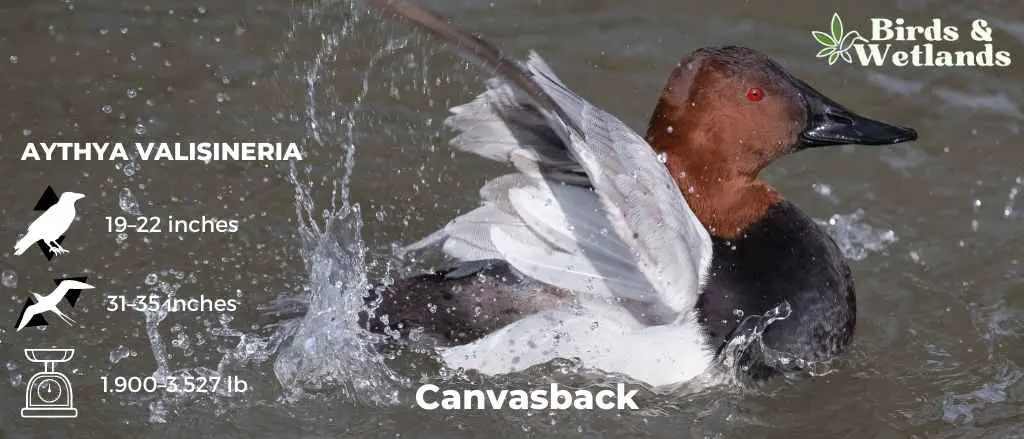
Canvasback
Canvasbacks are large diving ducks that have a dark head and neck and a pale gray body and are found all over the Northern Hemisphere.
Scientific Name: Aythya valisineria
Height: 48–56 cm (19–22 in)
Wingspan: 79–89 cm (31–35 in)
Weight: 862–1,600 g (1.900–3.527 lb)
Canvasback Description
The Canvasback makes a royal appearance. The male’s white back and flanks reminded English settlers of canvas fabric, hence the name. With a red-brown head and flashing crimson eyes, the drake (male) is a striking appearance.
It is a medium-sized duck that is easily recognizable by its distinct head pattern. Its bill is mostly orange with a dark tip, and it has a dark brown head and neck. Its body is primarily white with black speckles on the wings, back, and sides.
Canvasback Sound
Canvasback Habitat & Range
The habitat of the canvasback includes lakes and ponds in North America, Europe, Asia, and Australia. Canvasbacks breed in North America’s Prairie Pothole Region. They like to build their nests above water in permanent Prairie wetlands with emergent plants such as cattails and bulrushes for protection.

Canvasback
Canvasback Diet
The canvasback is a versatile feeder that can consume plants ranging in size from tiny strands to large leafy growths. It has been seen feeding upon countless species of aquatic vegetation, including pond weeds and wild celery as well! The bird also takes interest in snails or other mollusks for food sources not related directly with waterfowl production- think gastropods (slugs & snail shells) insects , small fish – which it may catch while hunting its own kind underwater among foliage near shallow coastal waters where these animals breed.
Canvasback Nesting
They nest in tree cavities and will lay anywhere from 8-15 eggs. The female incubates the eggs for 28-30 days while the male sits on them to keep them warm. When they hatch they are able to swim immediately!
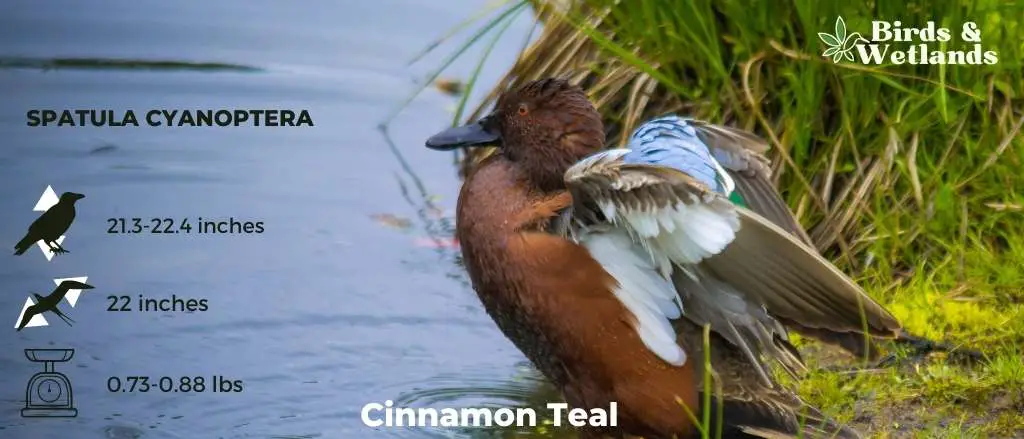
Listen to Cinnamon Teals
Cinnamon Teal is a small duck with distinctive bright cinnamon-colored feathers on its back and white markings above the eye that is native to North America and Central America.
The diet of this bird includes seeds, insects, and other invertebrates that are found near water sources where they live. Like most ducks, it feeds on aquatic vegetation such as pondweed, watercress, pondweed, and water lilies. This bird has also been known to eat insects and small crustaceans.
They are found in the northern hemisphere and are particularly common in North America, where they breed from Alaska to Canada. They winter south of the U.S., as well as in parts of Mexico and Central America.
The Cinnamon Teal is a very social bird, often living in large flocks during the breeding season and congregating around lakes and rivers during migration. They tend to be shy and elusive, so it can be difficult to see them in their natural habitat.
These birds mate for life and build nests on the ground near water sources—usually shallow ponds or marshes with tall grasses nearby for cover when young are being reared.
Scientific Name: Spatula cyanoptera
Height: 21.3-22.4 in (54-57 cm)
Wingspan: 22-inch (560 mm)
Weight: 11.8-14.1 oz (335-401 g)

Listen to Common Goldeneye Duck
The common goldeneye, often known as the goldeneye, is a medium-sized sea duck belonging to the Bucephala genus. The Barrow’s goldeneye is its closest cousin.
Males have white bodies with black backs. They also have dark green heads, bright yellow eyes and white patches on their cheeks.
Females have a short dark bill with a yellow tip at the end, pale yellow eyes and a brown head. They also have grayish bodies and a white neck collar.
Goldeneyes are also known for their unique calls. It sounds like a squeaky rubber toy being squeezed repeatedly. This makes them easy to identify by ear in addition to sight!
They are one of the most abundant ducks in North America, and they can be found in lakes, ponds, rivers, and marshes. The Common Goldeneye Duck prefers to live near shorelines where there are plenty of fish and vegetation available for food sources, but they can also be found living further inland near ponds or wetlands if necessary.
The Common Goldeneye Duck is listed as “least concern” by the International Union for Conservation of Nature (IUCN), which means that it isn’t threatened with extinction
Scientific Name: Bucephala clangula
Length:
Male: 45–51 cm (18–20 in)
Female: 40–50 cm (16–20 in)
Wingspan: 30.3-32.7 in (77-83 cm)
Weight:
Male: 1,000 g (2.2 lb)
Female: 800 g (1.8 lb)

Common Merganser
Listen to the Female Common Merganser Call
The common merganser, sometimes known as the goosander, is a huge sea duck found in wooded parts of Europe, Asia, and North America. They have a long bill that is pointed at the end and has a black tip on it. Their plumage is mostly dark with a white underside. They have very large feet and webbed toes to help them swim. Their legs are long and slender as well.
Common mergansers are omnivores, eating both plants and animals such as small fish or insects. They eat their prey by diving underwater and spearing it with their long bill before swallowing it whole.
The habitat of this bird is lakes, rivers, ponds, and marshes. They prefer quieter bodies of water with plenty of vegetation along the shores where they can rest during the day before moving on to hunt at night.
The current population of this bird is considered stable due to its ability to thrive even when there are threats present due to its adaptability as well as its wide range across North America.
Scientific Name: Mergus merganser
Length: 58–72 cm (23–28+1⁄2 in)
Wingspan: 78–97 cm (30+1⁄2–38 in)
Weight: 0.9–2.1 kg (2 lb 0 oz – 4 lb 10 oz)
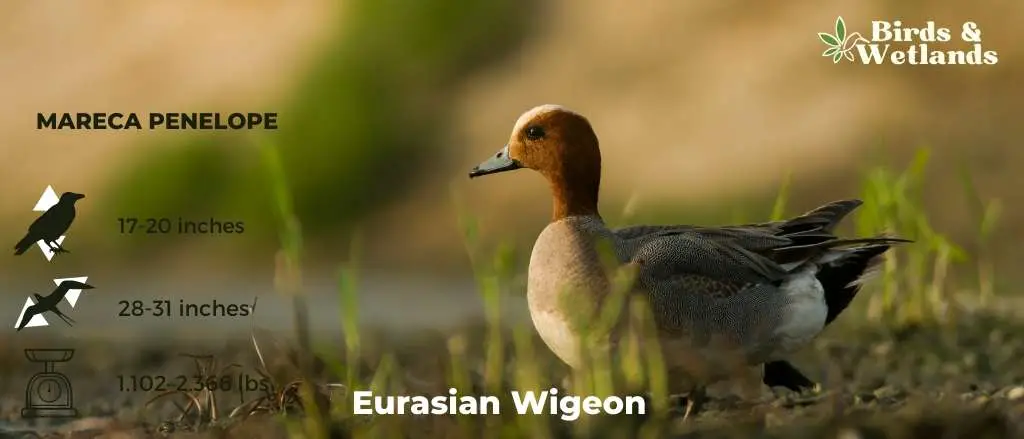
Eurasian Wigeon
Listen to Eurasian Wigeon
The Eurasian Wigeon, or European Wigeon, is a medium-sized duck with a long, pointed bill and a distinctive white crescent on the side of its face. The male Eurasian Wigeon has a light brown body with a dark green head and white cheek stripes on either side of its face. The female Eurasian Wigeon has a lighter brown body with a black head and white cheek stripes on either side of its face.
The diet of Eurasian Wigeon consists of vegetation such as roots, bulbs, tubers, and rhizomes from aquatic plants such as sedges, bulrushes, and other grasses as well as insects such as dragonflies or water boatmen. In wintertime, they feed on aquatic plants like duckweed or reeds in shallow water.
They are found in central and eastern Europe, Scandinavia, Russia, China, Korea, Japan, north-east Siberia and Alaska. They migrate between the breeding grounds in central Asia and southern Europe. They prefer nesting near lakes or ponds but they can also be found nesting on small streams. They can be spotted through Montana during spring migration.
The current population of Eurasian Wigeons is estimated at around 1 million birds worldwide with populations declining in many areas due to habitat loss.
Scientific Name: Mareca penelope
Height: 42–52 cm (17–20 in)
Wingspan: 71–80 cm (28–31 in)
Weight: 500–1,073 g (1.102–2.366 lb)
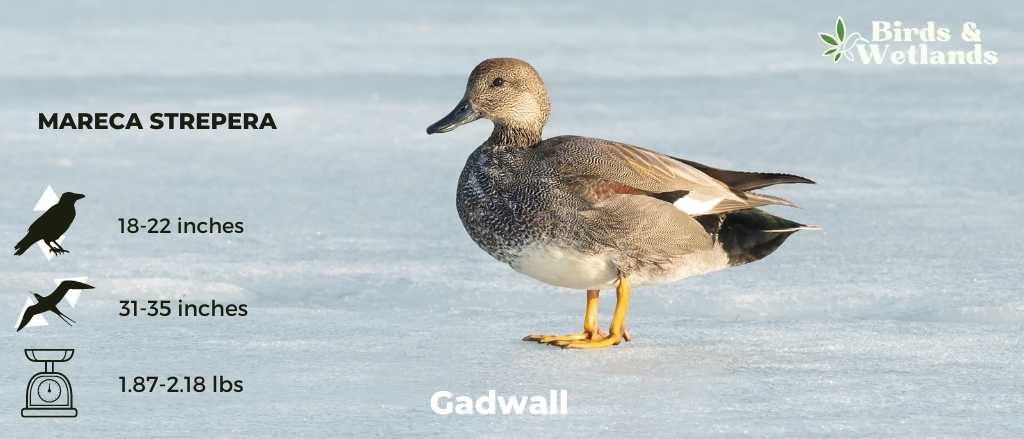
Gadwall
Listen to Gadwall
Gadwall is a duck that’s known for its yellow bill and the white patch on its cheek. It is native to North America, Europe, and Asia. It has a black head and breast, white cheeks, and a buff-colored body with an intricate pattern. The male’s bill is yellow with a dark tip.
The Gadwall’s color varies depending on its location—in North America, they are a dull brownish-gray, while in Europe their feathers are more of a chestnut brown. Their bills are black with a white tip, and their legs are yellowish-green above black webbed feet.
The only thing that sets them apart from other ducks is their eyes: they have dark brown eyes with a distinctive red circle around them.
Gadwalls are slightly smaller than mallards, with males weighing between 2 and 3 pounds and females weighing between 1.5 and 2 pounds.
Gadwalls eat insects, worms, crustaceans like crayfish, frogs, and tadpoles as well as small fish when available.
The Gadwall’s habitat is near water; it can be found in marshes, rice paddies, ponds, and lakes.
Gadwalls breed in northern North America and in Europe as far east as Siberia. They also breed in Asia where they are found in Japan, Korea, and China as well as Mongolia and Siberia.
They are migratory birds that fly south in the winter to warmer climates. They migrate south to winter in the southern USA, Mexico, and Central America as well as southern Europe (Spain), Central Africa (Ethiopia), and India. They are usually found in pairs or small flocks during migration and breeding season but tend to be solitary during winter months when they migrate southward.
This species of duck has experienced an increase in population over the last 100 years due to conservation efforts by governments and organizations such as Ducks Unlimited Canada (DUC).
Scientific Name: Mareca strepera
Height: 46–56 cm (18–22 in)
Wingspan: 78–90 cm (31–35 in)
Weight
Male: 990 g (35 oz)
Female: 850 g (30 oz

Garganey
Listen to Garganey
Garganey is a small duck with a slender body, long neck, and short bill. It has a black head, neck, and upperparts. The breast is white with dark spots in the center of each feather. The flanks are brownish-gray and the belly is white. The legs and feet are orange-yellow.
The Garganey feeds on insects, mollusks, fish, frogs, and worms. It nests near water, where it can be seen diving for food with its bill pointed downward.
The garganey’s habitat includes shallow freshwater lakes, ponds, and marshes with reeds or other tall vegetation near them. They live in flocks during the breeding season but tend to be solitary during migration and winter months.
It breeds over most of Europe and the Palearctic, as well as northern Asia and North America but it is purely migratory, with the whole population migrating to Southern Africa, India, Bangladesh, and Australasia during the Northern Hemisphere winter, when vast flocks may be seen.
The garganey is listed as Least Concern by IUCN due to its large range estimated at 1 million km2 (390 000 mi2).
Scientific Name: Spatula querquedula
Height: 41 cm
Wingspan: 58 – 69 cm
Weight: 300- 440 g

Greater Scaup
Listen to Greater Scaup
The Greater Scaup is a large diving duck with a distinctive white band on its head. The rest of its body is brown with a blue-grey sheen on its back and tail (which can be seen when they fly). The male is larger than the female, with a more pronounced bill and more white wing feathers. It has a black bill, black feet and legs, and gray plumage.
They prefer shallow water close to shore where they can feed on aquatic vegetation and small fish. They are omnivorous creatures who feed on mollusks, crustaceans, insects (especially water beetles), worms, and other small invertebrates like larval dragonflies which comprise about 60% of their diet.
This species breeds in the northern taiga regions of Canada and Alaska and winters in the Atlantic and Pacific Oceans, as well as some inland lakes. It is an uncommon sight in North America but can be found in many areas across Europe, Asia, Africa, and Australia. In winter, it migrates to southern Canada and parts of the northeastern United States.
Scientific Name: Aythya marila
Height: 39–56 cm (15–22 in)
Wingspan: 71–84 cm (28–33 in)
Weight: 726–1,360 g (1.601–2.998 lb)
Green-winged Teal (Anas crecca)
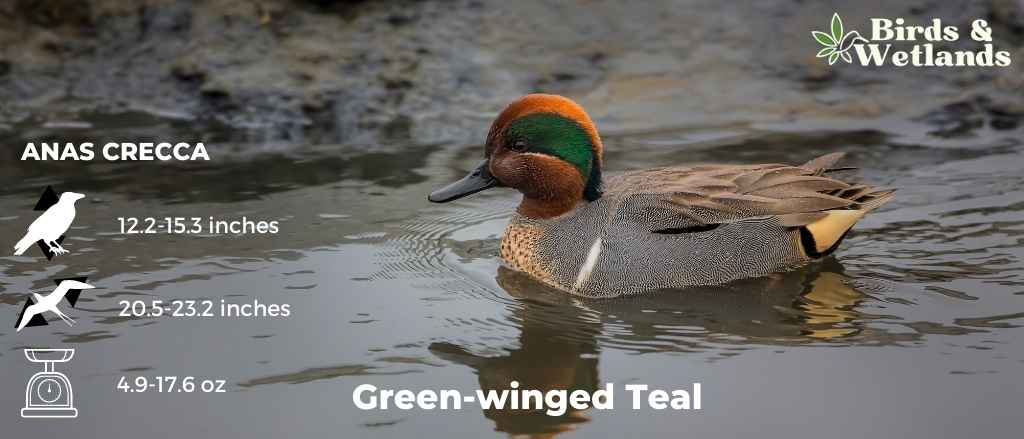
Green-winged Teals breed across northern North America. They are also known as “green wings” or “bluebills”. For a long time, it was believed conspecific with the Eurasian teal, but it has subsequently been classified as a separate species.
Scientific Name: Anas crecca
Height: 12.2-15.3 in (31-39 cm)
Wingspan: 20.5-23.2 in (52-59 cm)
Weight: 4.9-17.6 oz (140-500 g)
Description
Males have gray barred bodies, brown heads and white chests. Females and non-breeding males have mottled brown bodies. Both males and females have a visible green patch on their wings, especially while in flight.
Sound
Habitat & Range
This duck has been introduced into many parts of Europe and Asia where it has become an invasive species due to its ability to adapt to new environments quickly. As a result, it is now considered one of the world’s most invasive birds according to BirdLife International’s Global Invasive Species Database (GISD).
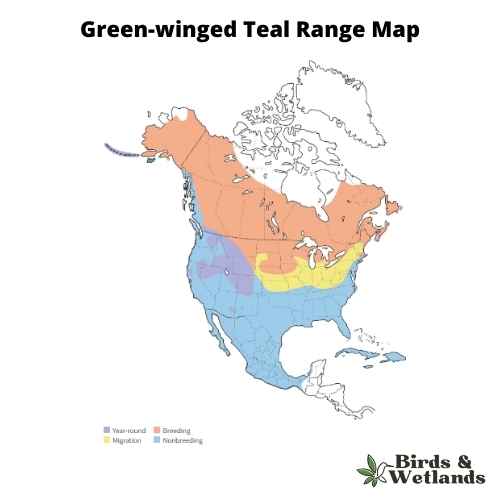
Green-winged Teal Diet
In the winter months, they eat grains, seeds and insects but during the summer months they switch over to eating aquatic plants like pondweeds, watercress, and duckweed which make up about 70% of their diet.
Green-winged Teal Nesting
The Green-winged teal nests on the ground near water sources such as streams or ponds. The female lays between 7-15 eggs per clutch (which means cluster) which incubate for 25 days before hatching out into ducklings!

Harlequin Duck
Listen to Harlequin Duck
The Harlequin Duck is a beautiful small sea duck that is native to North America. It has a unique appearance. It has a black head, neck, and breast, with white cheeks and sides of the neck, and red eyes. The body is black with white spots on the wings and tail feathers.
In addition to being unique-looking birds, Harlequin Ducks are also very vocal animals who make sounds such as whistles and squeaks that can be heard from up to 100 yards away! These sounds are used primarily for communication between other ducks within a flock but can also be used to alert predators of danger if needed (such as when approaching land).
These birds feed on small fish and crustaceans such as shrimp and clams. They can dive up to 20 feet below the surface to catch their prey.
It can be found in coastal areas of North America, Europe, and Asia, where it lives in salt marshes. It lives in freshwater lakes, ponds, and rivers. The species is monogamous and breeds in April and May.
Unfortunately, these beautiful creatures are currently under threat from habitat loss due to human development as well as overfishing.
Scientific Name: Histrionicus histrionicus
Length: 15–17 in (380–430 mm)
Wingspan: 26 in (660 mm)
Weight: 600 g (1.3 lb)

Listen to Hooded Mergansers
The hooded merganser, also known as the hooded duck, is a species of duck that lives in North America. It has a black head and a brown back. The male has yellow eyes while the female Hooded Merganser has dark eyes.
The Hooded Merganser is a relatively small duck with a slender body and a long tail. It has a white breast and belly, as well as a black cap and crest, which creates the illusion of the bird wearing a hood.
Hooded Mergansers eat mostly fish—they dive underwater to catch them! They also eat crayfish, crustaceans such as shrimp or krill, frogs, snails, and insects such as dragonflies or grasshoppers when they are unable to find enough food near the surface of water bodies.
The Hooded Mergansers live in North America and spends most of their time in freshwater ponds, lakes, and rivers during the spring breeding season. It moves to saltwater marshes during the winter months to avoid freezing temperatures.
The Hooded Mergansers arecurrently listed as Least Concern by the IUCN Red List because its population is stable or increasing and it has a large range.
Scientific Name: Lophodytes cucullatus
Length: 15.8-19.3 in (40-49 cm)
Wingspan: 23.6-26.0 in (60-66 cm)
Weight: 16.0-31.0 oz (453-879 g)

Lesser Scaup
Listen to Lesser Scaup
The lesser scaup is a tiny diving duck native to North America that winters in Central America. It is a smaller version of the Greater Scaup, and it can be distinguished from that species by its black breast, which contrasts with the white breast of the Greater Scaup.
They are one of the most abundant waterfowl in North America and are found across Canada and the United States. Because of its unusual blue bill, it is also called the small bluebill or broadbill.
The Lesser Scaup’s habitat is typically freshwater lakes, rivers, and streams. They can also be found on large ponds and reservoirs with plenty of aquatic vegetation.
Lesser Scaups eat mostly fish but also insects and small crustaceans, which they find by diving beneath the surface of the water for up to 40 seconds at a time. They are very territorial birds, so you may see several males fighting over territory during the breeding season.
Lesser scaups breed in ponds and lakes across Canada and much of the northern United States from late April through May. They usually nest in colonies with other species such as mallards or common goldeneyes.
The Lesser Scaup is not considered to be endangered or threatened and is currently listed as Least Concern by the International Union for Conservation of Nature (IUCN).
Scientific Name: Aythya affinis
Height: 41.7–43 cm (16.4–16.9 in)
Wingspan: 68–78 cm (27–31 in)
Weight: 454–1,089 g (1.001–2.401 lb)
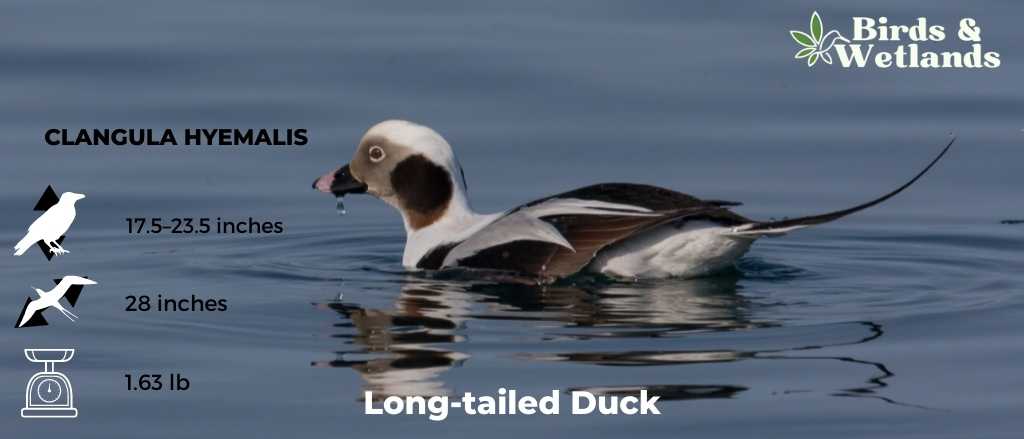
Long-tailed Duck
Listen to Long-tailed Duck
Long-tailed Ducks are species of duck that are native to Australia and New Zealand. They are named for their long, narrow tail feathers, which can be over 30% longer than the rest of their body. It has a black bill, brown eyes, and grayish-brown feathers on its back and wings. The underside of the bird is white in color.
The Long-tailed Duck eats aquatic plants, seeds, insects, snails, mollusks, crustaceans, fish eggs, and small fish. They can dive up to 60 feet below the surface.
These species of duck prefer to live in areas where there are plenty of lakes and ponds for them to feed on. They are also known for being very territorial so they tend not to share their space with other species unless they have no choice but to or if they’re trying to breed.
They are migratory birds, traveling from Canada to Europe during the summer months before returning south for winter months in North America or Asia.
They can be found in Europe, Asia, North America, and parts of South America. They breed in freshwater lakes from May through July or August depending on where they live. They migrate to southern latitudes during the winter months to avoid freezing temperatures.
Long-tailed Ducks have a current population of roughly 2 million individuals worldwide—that’s down from an estimated 4 million during the 1980s.
Scientific Name: Clangula hyemalis
Length: 440–600 mm (17.5–23.5 in)
Wingspan: 710 mm (28 in)
Weight: 740 g (1.63 lb)

Mallard
Listen to Mallard
The Mallard is a small, wild duck that lives in the United States and Canada. It’s a duck that is native to the Northern Hemisphere. It has a beautiful green head and a brown body, and it’s known for its long, lobed tail feathers.
They have black bills and yellow feet, which makes them easy to identify. Males have purple patches on their wings. The female Mallard has mainly brown-speckled plumage.
Their diet consists mostly of seeds, fruit, and insects. Mallards have been known to consume small rodents if they are available. They also eat frogs and fish when they can catch them. They usually feed at night in shallow water or on land near water sources.
Their habitat is primarily in wetlands such as ponds, lakes, and rivers. They also inhabit saltwater environments close to lands such as bays and estuaries.
They are also very social birds that travel in flocks during the breeding season and pair off into monogamous pairs during the winter months when they migrate southward to warmer climates where food sources are more plentiful.
Scientific Name: Anas platyrhynchos
Height: 50–65 cm (20–26 in)
Wingspan: 81–98 cm (32–39 in)
Weight: 0.7–1.6 kg (1.5–3.5 lb)
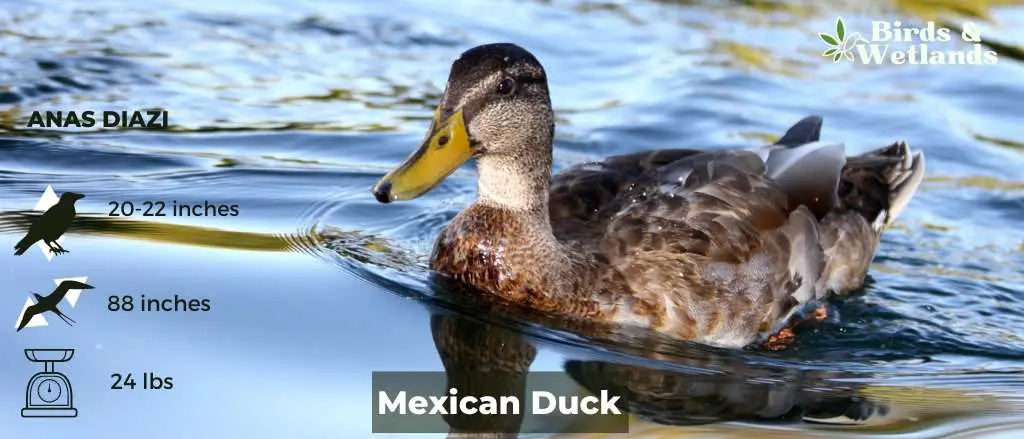
Mexican Duck
Listen to Mexican Duck
The Mexican Duck is a beautiful species that lives in Mexico and Central America. The Mexican Duck has a smaller head and neck than other duck species, and a brown body and tail. Its legs are also brown. These birds have long legs, short brown bills that curve upwards at the tips, and orange eyes.
Mexican ducks are omnivores that eat both plant matter and small animals such as insects or snails. They primarily eat aquatic vegetation like algae, water lilies or duckweed, and small fish, but will also eat small mammals, invertebrates such as snails or insects, and seeds from trees like oak or pine nuts.
Its habitat is mainly in the country’s mountain regions, but it is also found along the coastlines of Mexico, Central America, and northern South America, where it inhabits marshes, ponds, streams, rivers, lakes, and lagoons. They have adapted well to living near humans; they are often found around farms or even swimming pools.
The population of this bird has been declining in recent years, but they are still common enough to be spotted in the wild.
Scientific Name: Anas diazi
Height: 51–56 cm
Wingspan: 88 inches (2.24 meters).
Weight: 24 pounds (10.9 kg)

Listen to Northern Pintails
The Northern Pintail is an uncommon duck that can be found in North America and Europe. This duck is a medium-sized, strong-flying waterfowl with a long neck and tail.
Both sexes have grey legs and feet and a dark-gray bill. A faint white stripe runs from the rear of the drake’s chocolate-colored head down its neck to its mainly white undercarriage, making it more noticeable.
Additionally, males have gray bodies. The hen’s plumage is more muted, with dull brown feathers that resemble those of other female dabbling ducks. The drakes emit a flute-like whistle, while the hens make a harsh quack.
The Northern Pintail is a migratory bird that nests on or near open water with some floating vegetation nearby. This bird feeds on aquatic plants such as bulrush roots, pondweeds, and sedges; seeds from different plants like grass; insects such as dragonflies; fish; other small animals such as mice or frogs; and worms, which are their favorite food source for survival (when they’re not eating seeds).
There are approximately 1 million Northern Pintails left in the wild today.
Scientific Name: Anas acuta
Height:
Male: 59–76 cm (23–30 in)
Female: 51–64 cm (20–25 in)
Wingspan: 80–95 cm (31–37 in)
Weight:
Male: 450–1,360 g (0.99–3.00 lb)
Female: 454–1,135 g (1.001–2.502 lb)

Listen to Northern Shoveler
The northern shoveler, often known as the shoveler in the United Kingdom, is a common and ubiquitous duck. With its brown head and neck and breast, greenish-yellow bill and wings, white breast and belly, and the dark greenback, and black tail feathers.
This duck lives in freshwater ponds, marshes, lakes, rivers, and streams but will also sometimes inhabit brackish water areas where the water has a high salt content. It breeds in North America from Canada to Mexico, migrating south for the winter months.
The Northern Shoveler’s diet consists primarily of aquatic plants like duckweed and water lettuce. It also eats insects, worms, crustaceans, and mollusks if they can find them in the water.
Wintering in southern Europe, the Indian subcontinent, Southeast Asia, Central, the Caribbean, and northern South America, it breeds in northern Europe, through the Palearctic, and across much of North America.
Scientific Name: Spatula clypeata
Height: 16 in (41 cm)
Wingspan: 22-inch (560 mm)
Weight: 14 oz (400 g)
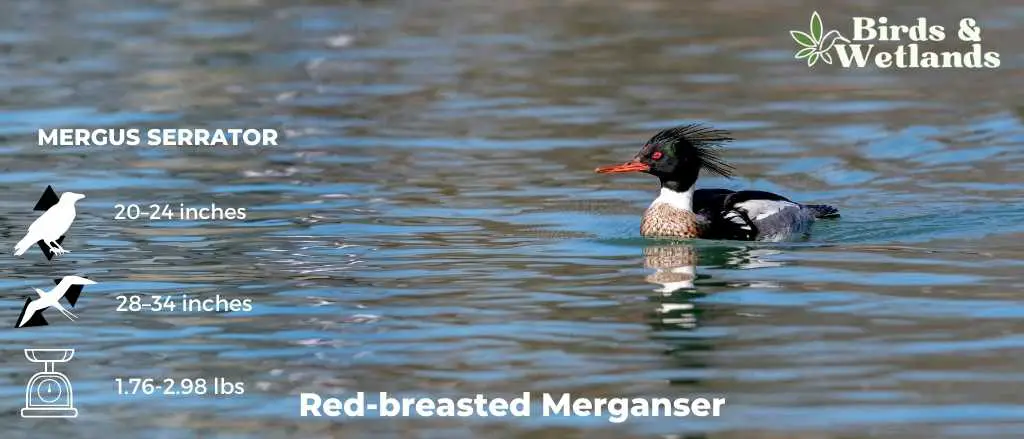
Listen to Red-breasted Mergansers
The Red-breasted Merganser has an appearance that makes it easy to identify. The feathers on their chest are red in coloration, and they have a white throat area. They are known for their bright red chests, which is what gives them their name.
This bird has a long body with a white underside and black head, neck, back, and tail. Its wings are brownish-grey and its bill is yellow with an orange tip.
These sea ducks feed on fish by diving into the water using their wings to propel themselves forward like penguins do when swimming under the water. They also eat amphibians such as frogs or newts if they can catch them.
The habitat of this bird includes lakes, rivers, and ponds where they can dive into the water to catch fish while swimming underwater or dive from above the water to catch fish at the bottom of your local pond. Red-breasted mergansers breed in boreal forests.
This bird is not endangered or threatened at this time because it has a very large population of over 8 million birds worldwide.
Scientific Name: Mergus serrator
Length: 51–62 cm (20–24 in)
Wingspan: 70–86 cm (28–34 in)
Weight: 28.2 to 47.6 oz (800 to 1,350 g)
Redhead (Aythya americana)
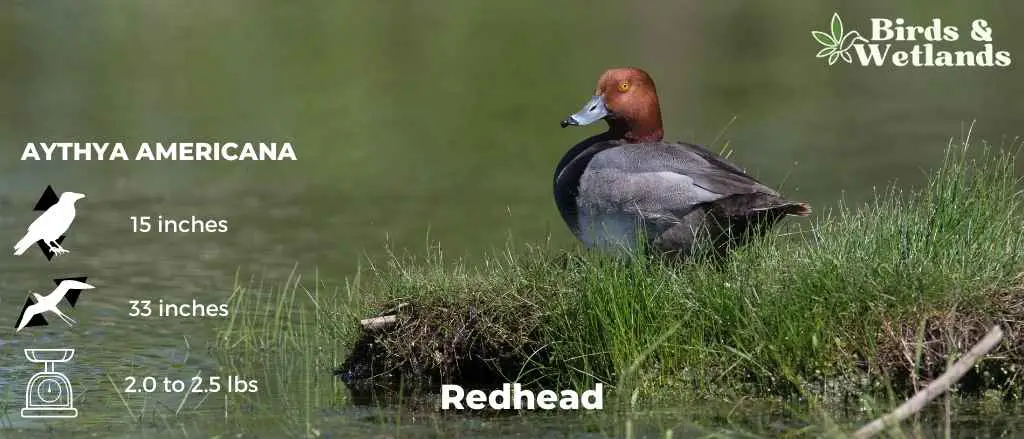
Redhead
The redhead duck is one of the most striking ducks in North America. It is easily recognizable by its bright orange-red head and black chest, which contrast sharply with their pale grey bodies. Redheads are also known for their distinctive call, which sounds like a high-pitched whistle.
Scientific Name: Aythya americana
Length: 37 cm (15 in)
Wingspan: 84 cm (33 in)
Weight: 2.0 to 2.5 lbs
Redhead Description
Redhead Ducks are a common sight at the pond. They have a red head and white body, with some gray feathers on their wings. They are about the size of a mallard duck, but have shorter legs and a longer bill.
Redhead Sound
Redhead Habitat & Range
Redheads can be found throughout North America, with the exception of southern Mexico and parts of the southeastern United States. They are most common in coastal areas and large rivers. In fact, many people mistake them for musk ducks when they see them in freshwater habitats. Redheads tend to prefer shallow waters with plenty of vegetation near shorelines or riverbanks instead of deeper water where musk ducks tend to prefer staying put.
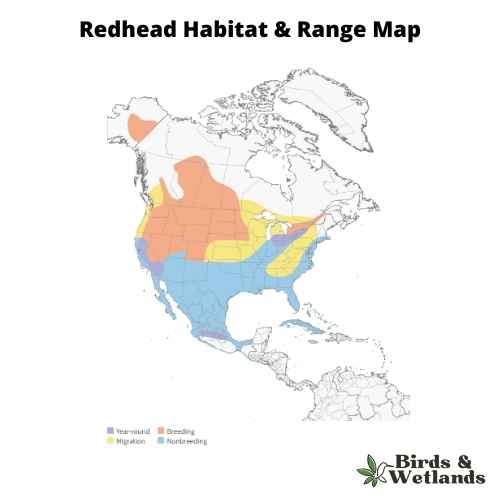
Redhead Range Map credit: https://www.allaboutbirds.org/
Redhead Diet
The redhead diet mainly consists of plant matter such as seeds, berries, shoots and buds from aquatic plants such as pondweed or cattails as well as insects such as dragonflies or small fish like minnows or smelt.
Redhead Nesting
The Redhead Duck lives on a diet of seeds and aquatic plants as well as insects and small fish. The female Redhead Duck lays between 8-12 eggs per clutch, which she then incubates for 28 days before they hatch. The male Redhead Duck will stay nearby while she is incubating her eggs and will care for them once they hatch by leading them to water where they can find food to eat.
Ring-necked Duck (Aythya collaris)

The Ring-necked Duck has a bright orange bill with a black tip and an olive-green head with a black mask across its eyes and down its beak. Its neck is white and speckled with gray, brown, or black patches. The rest of its body is grayish-brown to dark brown.
Scientific Name: Aythya collaris
Height: 15.3-18.1 in (39-46 cm)
Wingspan: 24.4-24.8 in (62-63 cm)
Weight: 17.3-32.1 oz (490-910 g)
Description
They are omnivorous so they also eat seeds and grains when they’re available too. They eat grasses, insects such as beetles and dragonflies when they’re available, seeds, and other types of plants like duckweed, water lilies, pondweeds, and grasses that grow along water edges or in open water areas.
Sound
Habitat & Range
It can be found throughout North America, Central America, and northern South America. It breeds in freshwater marshes, ponds, lakes, and streams. They’re also known to breed in saltwater marshes.
They use their bills to eat these things from the bottom of the lake or pond. They also swim underwater when they eat food. It prefers freshwater marshes, lakes, ponds, streams, rivers, and estuaries near forest edges where trees provide nesting sites for the ducklings.
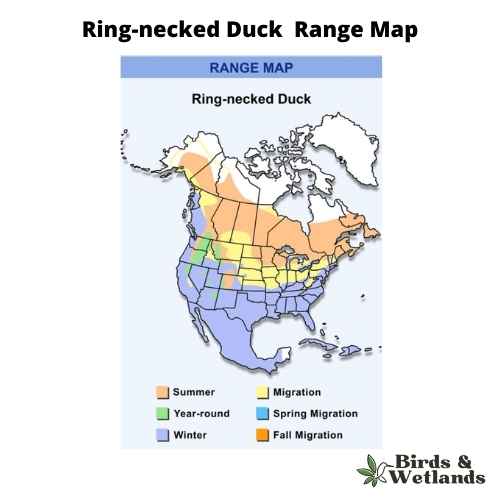
Ring-necked Duck Range Map credit: https://perceviaassets.azurewebsites.net/
Diet
They feed on aquatic plants like pondweed as well as insects and other invertebrates. They will also eat small crustaceans such as crabs or shrimp if they can find them in their habitat.
Ring-necked Duck Nesting
During breeding season (which is usually in April or May), males will form flocks on the water while females lay eggs in nests made from grasses near shorelines or floating on debris near shorelines where there are no predators present to threaten their young hatchlings.

Ruddy Duck
Listen to Ruddy Duck
Ruddy Duck is a medium-sized diving duck that’s native to North America. They’re known for their ruddy, or reddish-brown coloration, which is most prominent during the breeding season. Breeding males are unlike any other duck with their bright blue bills.
Ruddy Ducks are omnivorous, eating plants and insects as well as fish and small animals. It eats insects, grains, seeds, and aquatic plants. They are monogamous animals; they mate for life and have one clutch per year of 4-6 eggs that hatch after 25 days.
Ruddy Ducks frequently move in small groups of 5–15 birds at night. They’re also very sociable animals.
Ruddy Ducks live in freshwater lakes, ponds, rivers, marshes, and swamps. They are migratory birds that spend the winter in South America.
Ruddy Ducks are typically found in freshwater lakes and marshes during the breeding season (April through August), but they can also be seen on rivers or coasts during migration or wintering months (October through February).
Scientific Name: Oxyura jamaicensis
Length: 13.8-16.9 in (35-43 cm)
Wingspan: 22.1-24.4 in (56-62 cm)
Weight: 10.6-30.0 oz (300-850 g)

Surf Scoter
Listen to Surf Scoter
The Surf Scoter is a medium-sized sea duck black head, a colorful bill and white patches on the nape and forehead. They are “molt migrants,” meaning they migrate to an area where they may molt their flying feathers after nesting.
The Surf Scoter is an excellent swimmer, with webbed feet that allow it to dive after fish. They are able to dive deep into the ocean to find food, but they can only stay underwater for about 1 minute before having to come up for air.
The Surf Scoter’s diet consists of fish such as sand eels, anchovies, capelin, smelt, and herring. At times they can also feed on crustaceans such as krill or shrimp. It uses its bill to filter out small organisms from the water as it swims along the surface of the ocean.
The Surf Scoter breeds on Arctic coasts from Greenland to Alaska, but most populations migrate south to winter off California and Mexico. They can also be found along the coastlines of South America, Australia, New Zealand, and Japan.
Scientific Name: Melanitta perspicillata
Length:
Male: 48 cm (19 in)
Female: 44 cm (17 in)
Wingspan: 29.9-30.3 in (76-77 cm)
Weight:
Male: 1,050 g (2.31 lb)
Female: 900 g (2.0 lb)
Tufted Duck (Aythya fuligula)

Tufted Duck
The Tufted Duck is a small diving duck found in lakes and marshes throughout most of Europe.
Scientific Name: Aythya fuligula
Height: Male: 40.6-45.7 cm Female: 40.6-45.7 cm
Wingspan: Male: 20.2-21.2 cm Female: 19.4-20.7 cm
Weight: Male: 889.6 g Female: 768.3 g
Tufted Duck Description
Tufted Duck have a distinctive crest of feathers on the top of their heads that gives them their name, along with a long, slender bill and short legs. It is usually light brown with darker wings and a white underbelly.
Tufted Duck Sound
Tufted Duck Habitat & Range
Tufted Ducks are found throughout much of Europe as well as Asia, Central Africa and parts of Australia. They breed in shallow marshes or ponds where they construct nests out of grasses and rushes.
The population of this bird has been steadily declining due to habitat loss due to human development
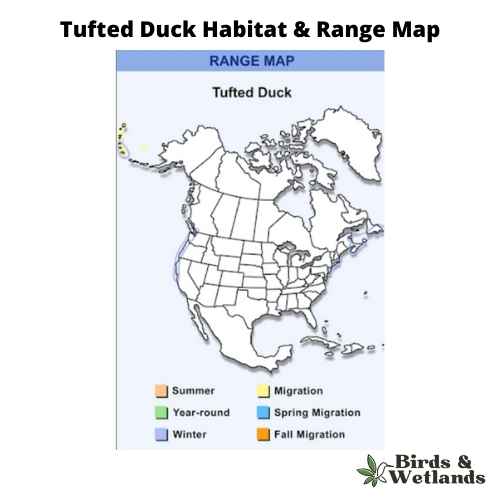
Tufted Duck Range Map credit: https://assets.whatbird.com/
Tufted Duck Diet
Tufted Ducks are omnivorous feeders, eating insects such as dragonflies, beetles, and flies as well as seeds from plants such as tall grasses. It also feeds on frogs, worms, and other small creatures that live in the mud at the bottom of ponds and lakes.
Tufted Duck Nesting
Tufted Ducks make their nests in tree cavities above ground level or near water sources where they can be easily accessed by their young once they hatch out of their eggs (which are laid in May). These birds are monogamous pairs who keep each other company throughout their lives together; however this does not mean that they mate for life: if one dies then the other will find another mate to replace him/her!
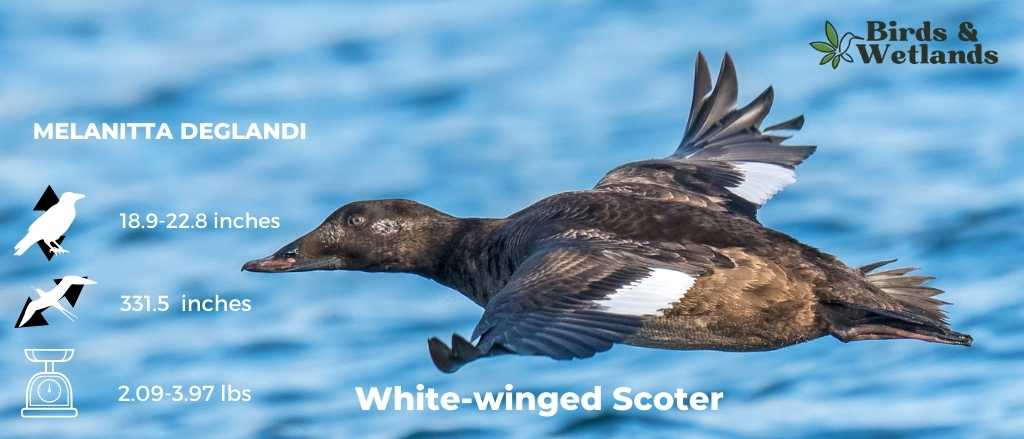
White-winged Scoter
Listen to White-winged Scoter
The White-winged Scoter is classified as an “oceanic” bird because it spends most of its time in marine waters. They have white feathers on their wings and are named after the white patch on their back. It is a medium-sized duck that has a black head, neck, and upper body, with a white breast and belly. The rest of its plumage is brown.
They feed primarily on mollusks, crustaceans, and fish, which they find by sweeping their bills side to side through the water in search of prey. When this happens, you’ll hear them make a loud clacking noise with their bills—which is how they got their name “scoter”.
It prefers to make its home near the coastlines of North America, Europe, and Asia. They can be found in large groups of other waterfowl but prefer to keep themselves separate from them.
They are migratory birds that make seasonal journeys between northern Canada and Mexico each spring/summer season before returning south for the winter months (December through April).
Scientific Name: Melanitta deglandi
Length: 18.9-22.8 in (48-58 cm)
Wingspan: 31.5 in (80 cm).
Weight: 33.5-63.5 oz (950-1800 g)

Wood Ducks
Listen to Wood Ducks
The Wood Duck is a medium-sized duck that has a long body, a short neck, and a large head. It has a bright red patch of skin at the base of its bill. The male wood duck is colorful with a green crown and brown breast. The female wood duck has a brown body with a blue patch on its wings.
They are omnivores meaning they eat both plants such as cherries and grapes, aquatic plants such as pondweeds and water lilies, and animals but are mainly insectivores feeding on small invertebrates such as insects and worms.
They live in wooded areas near water sources like ponds, lakes, rivers, streams, marshes, and swamps. They live in large flocks during the breeding season and then move to smaller groups during migration or winter.
Their population was in serious decline in the late 19th century as a result of severe habitat loss and market hunting both for meat and plumage for the ladies’ hat market in Europe. By the beginning of the 20th century, wood ducks had virtually disappeared from much of their former range.
Scientific Name: Aix sponsa
Height: 47 to 54 cm (19 to 21 in) ( or 1.5 feet max.)
Wingspan: 66 to 73 cm (26 to 29 in)
Weight: 454-862 g (16.0-30.4 oz)
Where to Watch Ducks in Montana?
Montana, renowned for its sprawling landscapes, picturesque wetlands, and diverse habitats, is an exceptional destination for birdwatchers and nature enthusiasts looking to observe a wide array of duck species.
Notable birdwatching locations within the state include the Ninepipe National Wildlife Refuge, the Lee Metcalf National Wildlife Refuge, and the Red Rock Lakes National Wildlife Refuge, all offering ample opportunities for exploration and admiration of these captivating ducks.
Glacier National Park is home to thousands of Harlequin Ducks. You can see these lively waterfowl diving and swim in the park’s many lakes, ponds and streams.
Bowdoin National Wildlife Refuge is another excellent spot for duck watching. The refuge is an important stopover for geese and ducks during their migration toward the south. So, you’re sure to see various species if you visit during the right time of year.
Freezeout Lake Wildlife Management Area is a breeding ground for many dabbling and diving ducks. Nesting season starts in May, so this is the perfect place to go if you want to see baby ducks!
Consider visiting neighbouring states where even more fascinating birdlife can be discovered. To the north, you can explore the enchanting world of ducks in North Dakota and marvel at the diverse species that inhabit the state’s wetlands.
Venturing eastward, you’ll encounter the picturesque landscapes of South Dakota, which host the intriguing duck populations in South Dakota, offering a fresh perspective on these delightful birds.
Head south and delve into the duck habitats in Wyoming and immerse yourself in the state’s rich ecosystems, appreciating the beauty and variety of ducks found throughout the region.
Duck Hunting in Montana
Hunting ducks in the state of Montana is a great way to enjoy the outdoors and take advantage of the state’s abundant natural resources. Ducks are a common sight in Montana, and many different species can be found in the state, including mallards, wood ducks, and pintails.
Hunting season for ducks typically runs from October to January. Waterfowl hunters must have valid Conservation and Base Hunting Licenses, Migratory Bird License, Federal Migratory Bird Stamp and participation in National Harvest Survey Program.
In addition, the state has daily bag and possession limits on how many birds you can hunt.
Can You Shoot Ducks in Montana?
Yes, you can shoot ducks in Montana. However, only approved non-toxic shots are allowed when hunting waterfowl including ducks. Lead shots and other toxic shots are strictly prohibited.
Where Can I Hunt Ducks in Montana?
There’s no shortage of ducks in the state of Montana. It produces large numbers of ducks annually with abundant grasslands, prairies and pastures. While waterfowl hunting is shadowed by big game hunting in the state, still, Montana offers plenty of duck hunting opportunities.
One of the state’s most popular duck hunting locations is the Beaverhead River, a winding waterway that features numerous warm springs and wetlands. The area is home to many different species of ducks, making it a popular destination for duck hunters. The river also provides an excellent opportunity for hunters to view ducks in their natural habitat.
Final Thoughts on Ducks in Montana
Montana has diverse landscapes and abundant waterways. Moreover, the state lies in two important migration routes — the Pacific Flyway and the Central Flyway. So, it is unsurprising that many migrating birds from the north use the Big Sky Country as a significant stopover during migration.
In addition, the state is home to various ecosystems, including grasslands, rivers, ponds, marshes and wetlands. These habitats provide ideal conditions for ducks to live and breed. There are also plenty of domesticated ducks such as Muscovy ducks that live in the state.


